Development of Geopolymer-Based Materials with Ceramic Waste for Artistic and Restoration Applications
Abstract
1. Introduction
2. Experimental Section
2.1. Materials
2.2. Sample Preparation
2.2.1. Geopolymer (MK)
2.2.2. Geopolymer Mortars
2.2.3. Curing Treatments
2.3. Methods
3. Results and Discussion
3.1. X-ray Diffraction Characterization
3.2. Microstructural Analysis
3.3. Physical and Mechanical Properties
3.4. Applications in the Field of the Creative Industry and Cultural Heritage
4. Conclusions
Author Contributions
Funding
Institutional Review Board Statement
Informed Consent Statement
Data Availability Statement
Acknowledgments
Conflicts of Interest
References
- Confindustria Ceramica. 2019. Available online: http://www.confindustriaceramica.it/site/home/news/documento5751.html (accessed on 21 November 2022).
- Martín-Márquez, J.; Rincón, J.M.; Romero, M. Effect of firing temperature on sintering of porcelain stoneware tiles. Ceram. Int. 2008, 34, 1867–1873. [Google Scholar] [CrossRef]
- Pérez, J.M.; Romero, M. Microstructure and technological properties of porcelain stoneware tiles moulded at different pressures and thicknesses. Ceram. Int. 2014, 40, 1365–1377. [Google Scholar] [CrossRef]
- Bovea, M.D.; Díaz-Albo, E.; Gallardo, A.; Colomer, F.J.; Serrano, J. Environmental performance of ceramic tiles: Improvement proposals. Mater. Des. 2010, 31, 35–41. [Google Scholar] [CrossRef]
- El-Dieb, A.S.; Taha, M.R.; Kanaan, D.; Aly, S.T. Ceramic waste powder: From landfill to sustainable concretes. Proc. Inst. Civ. Eng. Constr. Mater. 2018, 171, 109–116. [Google Scholar] [CrossRef]
- Pacheco-Torgal, F.; Jalali, S. Retraction Note: Compressive strength and durability properties of ceramic wastes based concrete. Mater. Struct. 2021, 54, 153. [Google Scholar] [CrossRef]
- Silva, T.H.; de Resende, M.C.; de Resende, D.S.; Ribeiro Soares, P.R., Jr.; da Silva Bezerra, A.C. Valorization of ceramic sludge waste as alternative flux: A way to clean production in the sanitary ware industry. Clean. Eng. Technol. 2022, 7, 100453. [Google Scholar] [CrossRef]
- European Commission. Directorate-General for Budget, The EU’s 2021–2027 Long-Term Budget & Next Generation EU: Facts and Figures, Publications Office. 2021. Available online: https://data.europa.eu/doi/10.2761/808559 (accessed on 21 November 2022).
- Rambaldi, E.; Esposito, L.; Tucci, A.; Timellini, G. Recycling of polishing porcelain stoneware residues in ceramic tiles. J. Eur. Ceram. Soc. 2007, 27, 3509–3515. [Google Scholar] [CrossRef]
- Sun, Z.; Cui, H.; An, H.; Tao, D.; Xu, Y.; Zhai, J.; Li, Q. Synthesis and thermal behavior of geopolymer-type material from waste ceramic. Constr. Build. Mater. 2013, 49, 281–287. [Google Scholar] [CrossRef]
- Medri, V.; Landi, E. Recycling of porcelain stoneware scraps in alkali bonded ceramic composites. Ceram. Int. 2014, 40, 307–315. [Google Scholar] [CrossRef]
- Reig, L.; Sanz, M.A.; Borrachero, M.V.; Monzó, J.; Soriano, L.; Payá, J. Compressive strength and microstructure of alkali-activated mortars with high ceramic waste content. Ceram. Int. 2017, 43, 13622–13634. [Google Scholar] [CrossRef]
- Luhar, I.; Luhar, S.; Abdullah, M.M.A.B.; Nabiałek, M.; Sandu, A.V.; Szmidla, J.; Jurczyńska, A.; Razak, R.A.; Aziz, I.H.A.; Jamil, N.H.; et al. Assessment of the Suitability of Ceramic Waste in Geopolymer Composites: An Appraisal. Materials 2021, 14, 3279. [Google Scholar] [CrossRef] [PubMed]
- Ramos, G.A.; de Matos, P.R.; Pelisser, F.; Gleize, P.J.P. Effect of porcelain tile polishing residue on eco-efficient geopolymer: Rheological performance of pastes and mortars. J. Build. Eng. 2020, 32, 101699. [Google Scholar] [CrossRef]
- Hayles, C.S. Environmentally sustainable interior design: A snapshot of current supply of and demand for green, sustainable or Fair Trade products for interior design practice. Int. J. Sustain. Built Environ. 2015, 4, 100–108. [Google Scholar] [CrossRef]
- NPCS Board of Consultants & Engineers. The Complete Technology Book on Steel and Steel Products; Asia Pacific Business Press Inc.: New Delhi, India, 2008; ISBN 8178330180, 9788178330181. [Google Scholar]
- Zeyad, A.M.; Magbool, H.M.; Tayeh, B.A.; de Azevedo AR, G.; Abutaleb, A.; Hussain, Q. Production of geopolymer concrete by utilizing volcanic pumice dust. Case Stud. Constr. Mater. 2022, 16, e00802. [Google Scholar] [CrossRef]
- Provis, J.L. Green concrete or red herring?—Future of alkali-activated materials. Adv. Appl. Ceram. 2014, 113, 472–477. [Google Scholar] [CrossRef]
- Davidovits, J. Geopolymer Chemistry and Applications, 5th ed.; Geopolymer Institute: Saint-Quentin, France, 2020; ISBN 9782954453118. [Google Scholar]
- Singh, B.; Ishwarya, G.; Gupta, M.; Bhattacharyya, S. Geopolymer concrete: A review of some recent developments. Constr. Build. Mater. 2015, 85, 78–90. [Google Scholar] [CrossRef]
- Duxon, P.; Fernandez-Jiminez, A.; Provis, J.L.; Luckey, G.C.; Palomo, A.; Van Deventure, J.S.J. Geopolymer technology: The current state of the art. J. Mater. Sci. 2007, 42, 2917–2933. [Google Scholar] [CrossRef]
- Provis, J.L.; Van Deventer, J.S.J. (Eds.) Geopolymers, Structure, Processing, Properties and Application; Woodhead Publishing Limited: Cambridge, UK, 2009. [Google Scholar]
- Davidovits, J. Geopolymers: Inorganic polymeric new materials. J. Therm. Anal. 1991, 37, 1633–1656. [Google Scholar] [CrossRef]
- Nikolov, A.; Rostovsky, I.; Nugteren, H. Geopolymer materials based on natural zeolite. Case Stud. Constr. Mater. 2017, 6, 198–205. [Google Scholar] [CrossRef]
- Nasaeng, P.; Wongsa, A.; Cheerarot, R.; Sata, V.; Chindaprasirt, P. Strength enhancement of pumice-based geopolymer paste by incorporating recycled concrete and calcined oyster shell powders. Case Stud. Constr. Mater. 2022, 17, e01307. [Google Scholar] [CrossRef]
- Occhicone, A.; Vukcevic, M.; Boskovic, I.; Mingione, S.; Ferone, C. Alkali-Activated Red Mud and Construction and Demolition Waste-Based Components: Characterization and Environmental Assessment. Materials 2022, 15, 1617. [Google Scholar] [CrossRef] [PubMed]
- Occhicone, A.; Vukčević, M.; Bosković, I.; Ferone, C. Red mud-blast furnace slag-based alkali-activated materials. Sustainability 2021, 13, 11298. [Google Scholar] [CrossRef]
- Shaikh, F. Review of mechanical properties of short fiber reinforced geopolymer composites. Constr. Build. Mater. 2013, 43, 37–49. [Google Scholar] [CrossRef]
- Sakulich, A. Reinforced geopolymer composites for enhanced material greenness and durability. Sustain. Cities Soc. 2011, 1, 195–210. [Google Scholar] [CrossRef]
- Ricciotti, L.; Molino, A.J.; Roviello, V.; Chianese, E.; Cennamo, P.; Roviello, G. Geopolymer Composites for Potential Applications in Cultural Heritage. Environments 2017, 4, 91. [Google Scholar] [CrossRef]
- Colangelo, F.; Roviello, G.; Ricciotti, L.; Ferrándiz-Mas, V.; Messina, F.; Ferone, C.; Tarallo, O.; Cioffi, R.; Cheeseman, C.R. Mechanical and thermal properties of lightweight geopolymer composites containing recycled expanded polystyrene. Cem. Concr. Compos. 2018, 86, 266–272. [Google Scholar] [CrossRef]
- Roviello, G.; Menna, C.; Tarallo, O.; Ricciotti, L.; Messina, F.; Ferone, C.; Asprone, D.; Cioffi, R. Lightweight geopolymer-based hybrid materials. Compos. Part B Eng. 2017, 128, 225–237. [Google Scholar] [CrossRef]
- Roviello, G.; Menna, C.; Tarallo, O.; Ricciotti, L.; Ferone, C.; Colangelo, F.; Asprone, D.; di Maggio, R.; Cappelletto, E.; Prota, A.; et al. Preparation, structure and properties of hybrid materials based on geopolymers and polysiloxanes. Mater. Des. 2015, 87, 82–94. [Google Scholar] [CrossRef]
- Roviello, G.; Ricciotti, L.; Ferone, C.; Colangelo, F.; Tarallo, O. Fire resistant melamine based organic-geopolymer hybrid composites. Cement Concrete Compos. 2015, 59, 89–99. [Google Scholar] [CrossRef]
- Ferone, C.; Roviello, G.; Colangelo, F.; Cioffi, R.; Tarallo, O. Novel hybrid organic-geopolymer materials. Appl. Clay Sci. 2013, 73, 42–50. [Google Scholar] [CrossRef]
- Roviello, G.; Ricciotti, L.; Ferone, C.; Colangelo, F.; Cioffi, R.; Tarallo, O. Synthesis and Characterization of Novel Epoxy Geopolymer Hybrid Composites. Materials 2013, 6, 3943–3962. [Google Scholar] [CrossRef] [PubMed]
- Colangelo, F.; Roviello, G.; Ricciotti, L.; Ferone, C.; Cioffi, R. Preparation and characterization of new geopolymer-epoxy resin hybrid mortars. Materials 2013, 6, 2989–3006. [Google Scholar] [CrossRef] [PubMed]
- Roviello, G.; Ricciotti, L.; Molino, A.J.; Menna, C.; Ferone, C.; Asprone, D.; Cioffi, R.; Ferrandiz-Mas, V.; Russo, P.; Tarallo, O. Hybrid fly ash-based geopolymeric foams: Microstructural, thermal and mechanical properties. Materials 2020, 13, 2919. [Google Scholar] [CrossRef] [PubMed]
- Sithole, N.T.; Ntuli, F.; Okonta, F. Fixed bed column studies for decontamination of acidic mineral effluent using porous fly ash-basic oxygen furnace slag based geopolymers. Miner. Eng. 2020, 154, 106397. [Google Scholar] [CrossRef]
- Roviello, G.; Chianese, E.; Ferone, C.; Ricciotti, L.; Roviello, V.; Cioffi, R.; Tarallo, O. Hybrid geopolymeric foams for the removal of metallic ions from aqueous waste solutions. Materials 2019, 12, 4091. [Google Scholar] [CrossRef] [PubMed]
- Roviello, G.; Ricciotti, L.; Molino, A.J.; Menna, C.; Ferone, C.; Cioffi, R.; Tarallo, O. Hybrid Geopolymers from Fly Ash and Polysiloxanes. Molecules 2019, 24, 3510. [Google Scholar] [CrossRef]
- Ricciotti, L.; Occhicone, A.; Petrillo, A.; Ferone, C.; Cioffi, R.; Roviello, G. Geopolymer-based hybrid foams: Lightweight materials from a sustainable production process. J. Clean. Prod. 2020, 250, 119588. [Google Scholar] [CrossRef]
- Botti, R.F.; Innocentini, M.D.M.; Faleiros, T.A.; Mello, M.F.; Flumignan, D.L.; Santos, L.K.; Franchin, G.; Colombo, P. Biodiesel Processing Using Sodium and Potassium Geopolymer Powders as Heterogeneous Catalysts. Molecules 2020, 25, 2839. [Google Scholar] [CrossRef]
- Thokchom, S.; Ghosh, P.; Ghosh, S. Eeffect of water absorption, porosity and sorptivity on durability of geopolymer mortars ARPN. J. Eng. Appl. Sci. 2009, 4, 28–32. [Google Scholar]
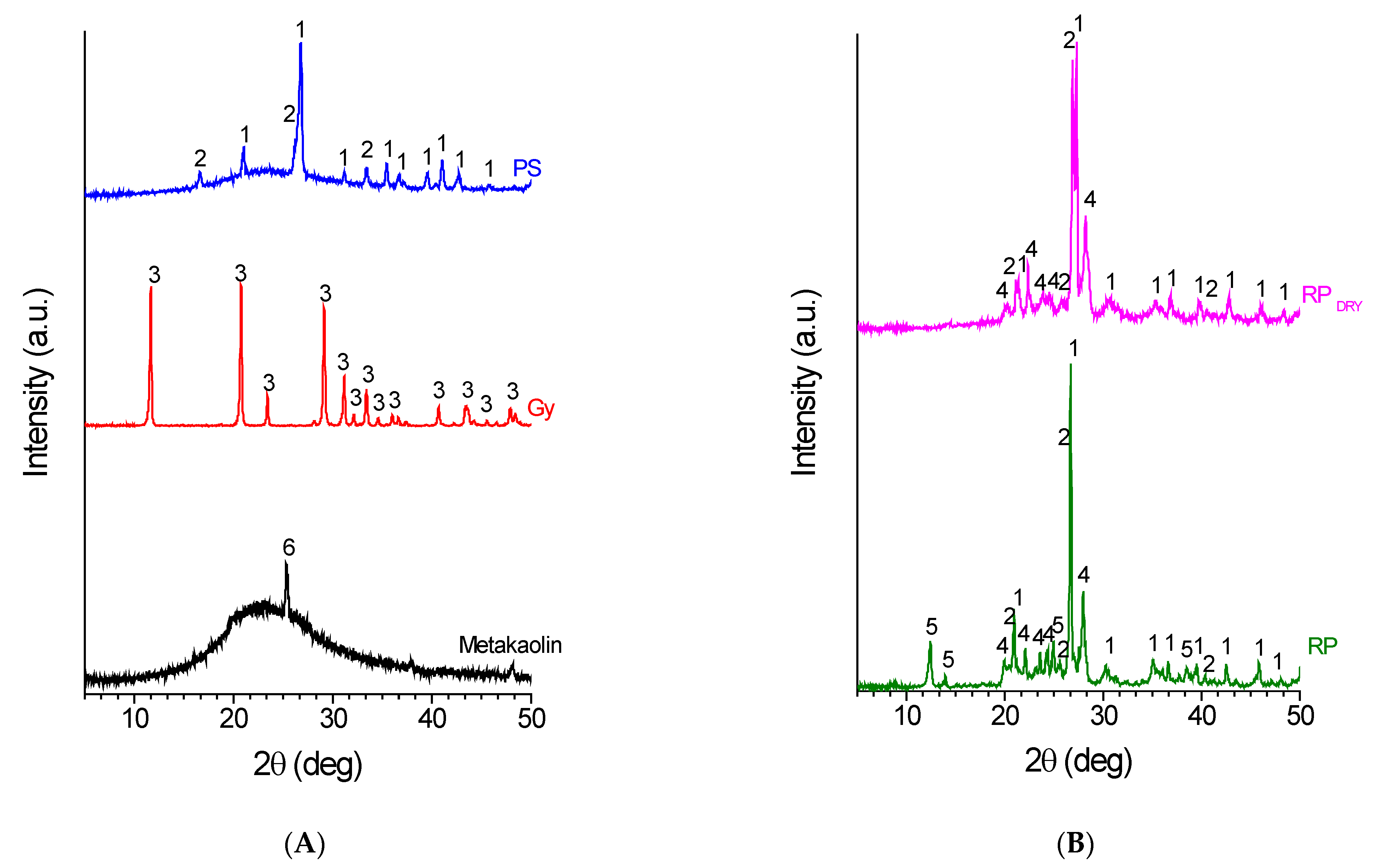
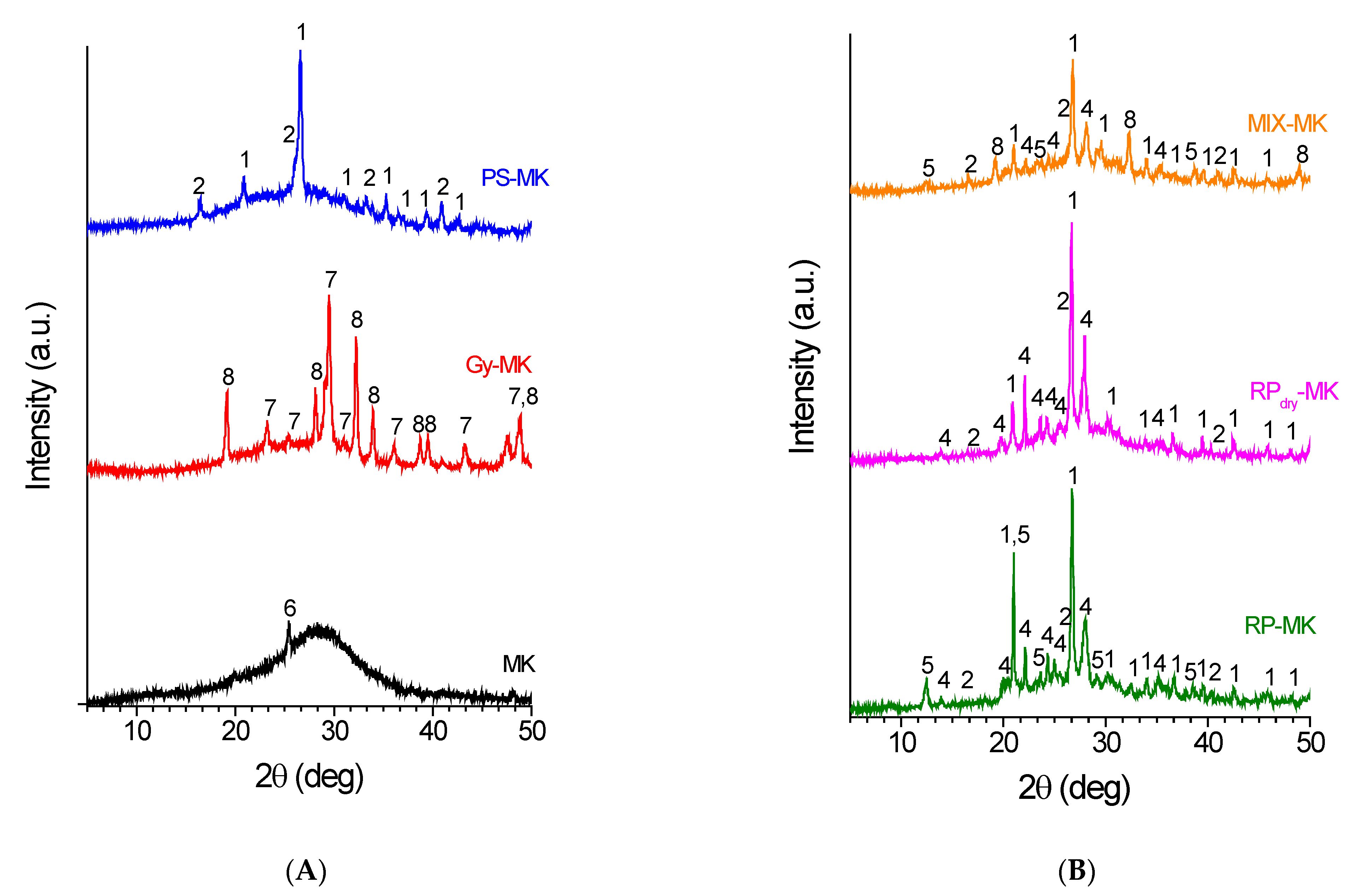
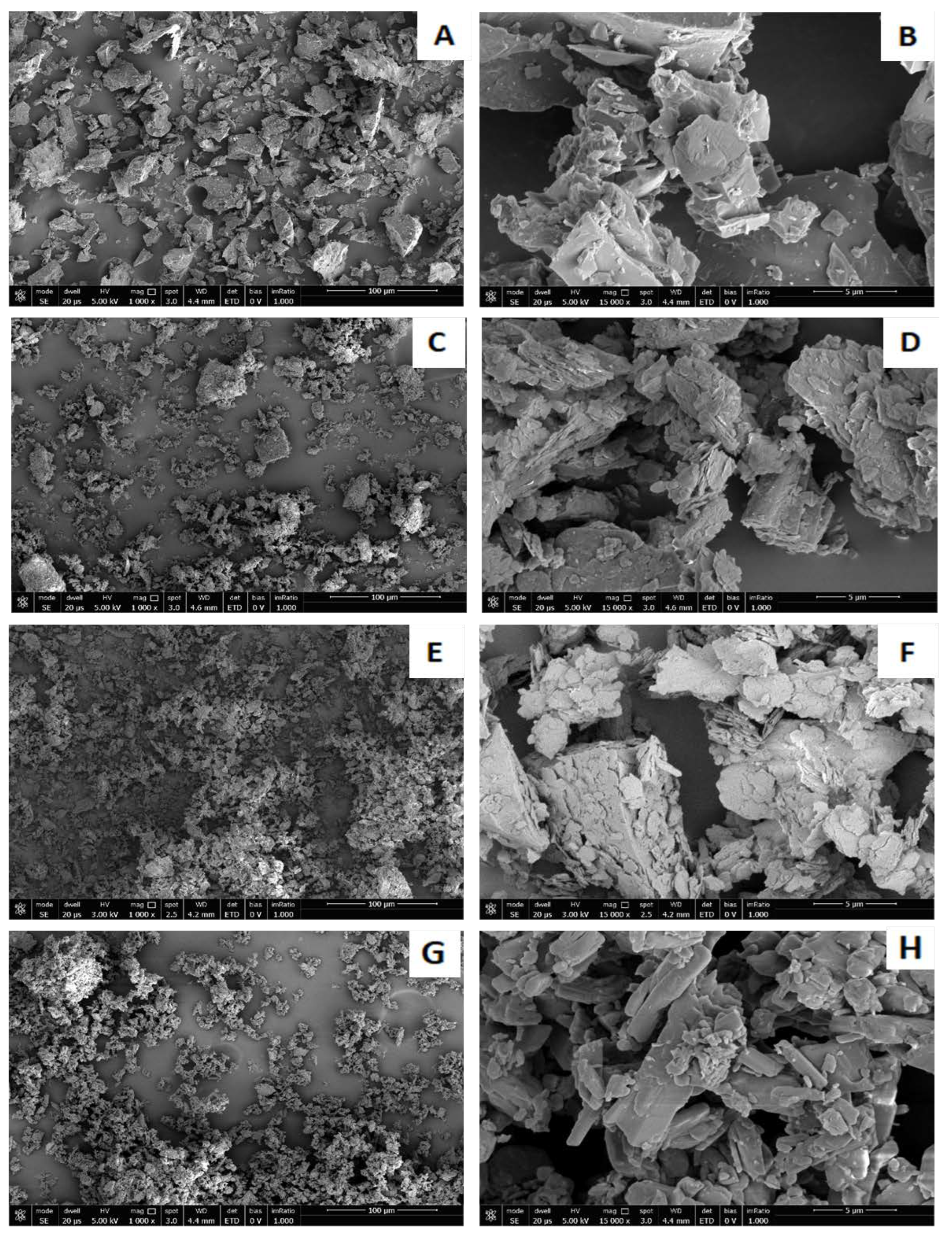
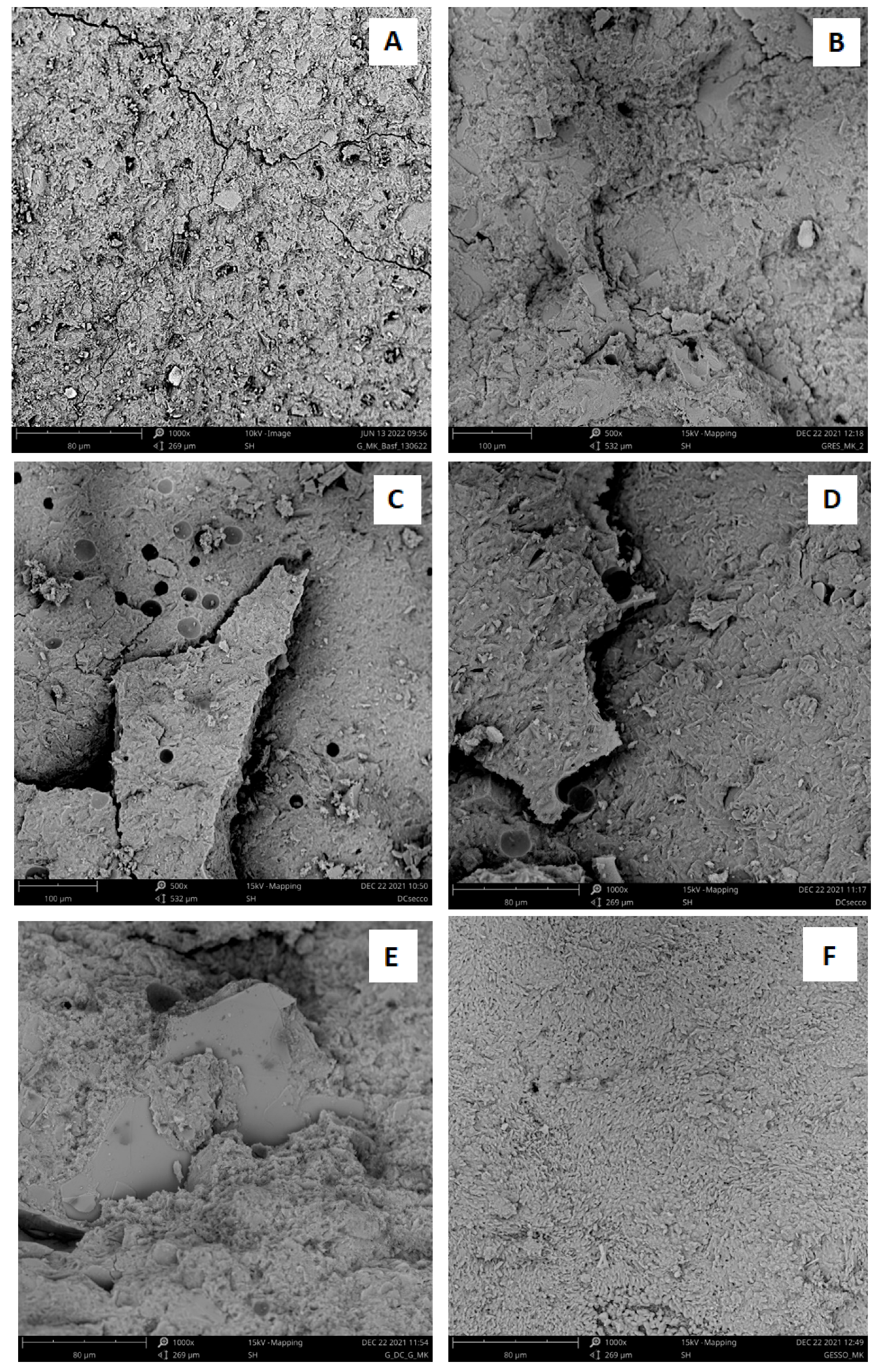
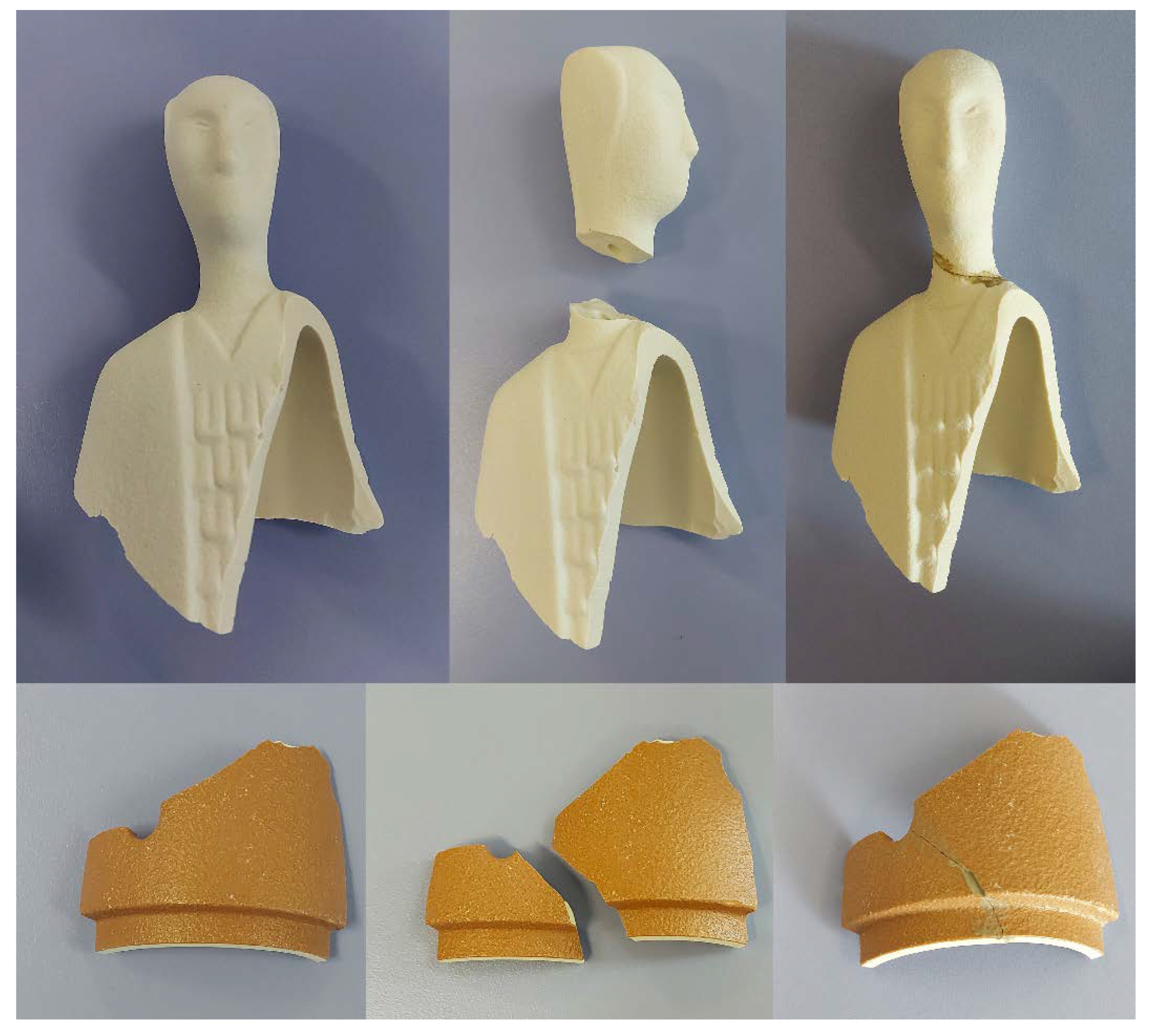

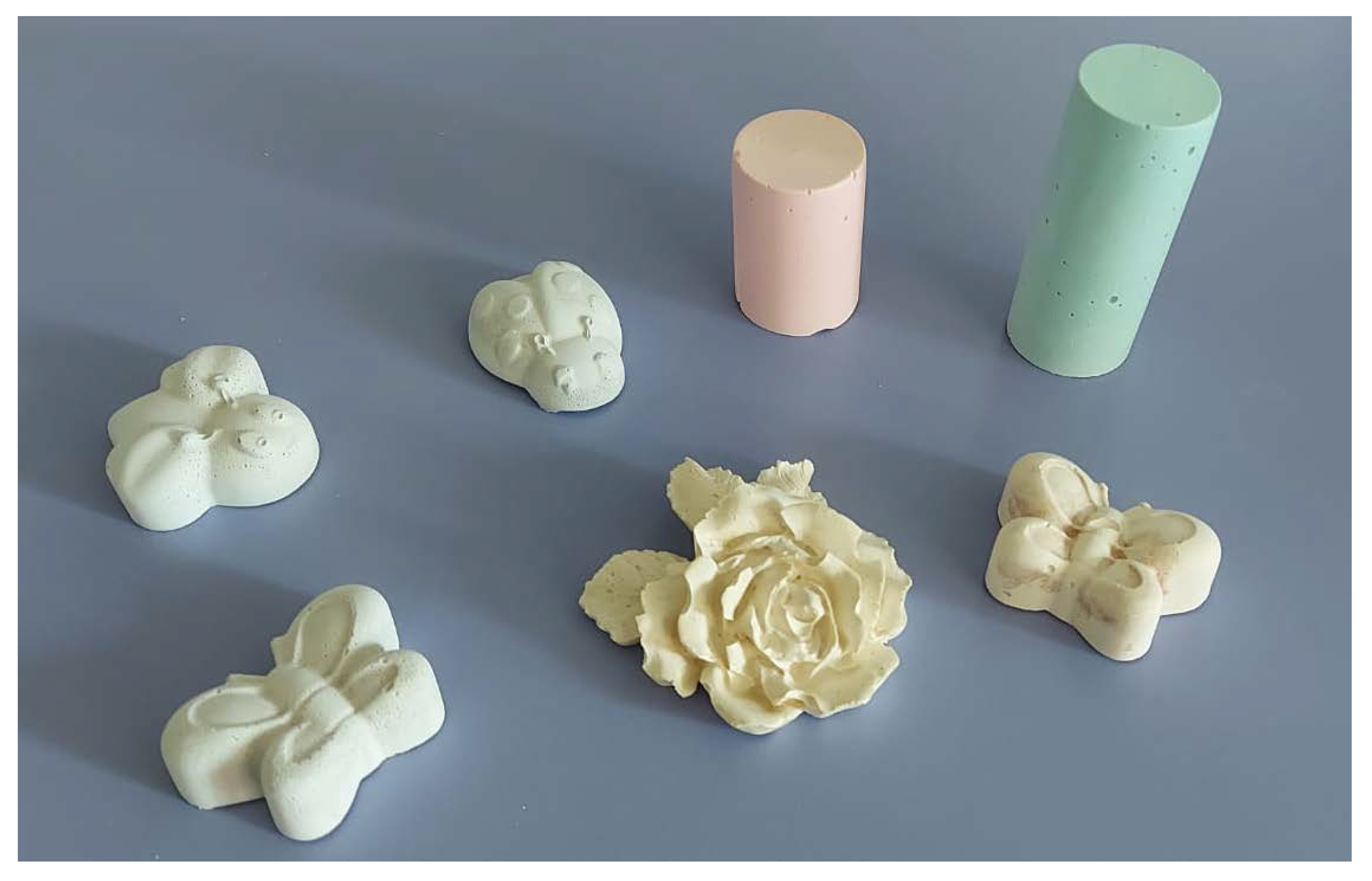
| Compound | Metakaolin | Sodium Silicate |
|---|---|---|
| SiO2 | 52.2 | 27.40 |
| Al2O3 | 45.1 | - |
| Na2O | 0.22 | 8.15 |
| K2O | 0.15 | - |
| TiO2 | 1.75 | - |
| Fe2O3 | 0.42 | - |
| CaO | 0.04 | - |
| MgO | 0.04 | - |
| P2O5 | 0.08 | - |
| H2O | - | 64.45 |
| Materials (wt.%) | MK | PS-MK | RP-MK | RPdry-MK (1) | Gy-MK | MIX-MK |
|---|---|---|---|---|---|---|
| Metakaolin | 37.5 | 11 | 11.8 | 11.6 | 15.3 | 11 |
| NaOH | 7.2 | 5.2 | 5.6 | 5.6 | 7.3 | 5.2 |
| Sodium silicate | 55.3 | 40 | 43 | 42.7 | 56.1 | 40 |
| Pressed burnt and extruded ceramic waste | - | 43.8 | - | - | - | 20.9 |
| Raw pressed | - | - | 39.6 | 40.1 | - | 16.3 |
| Gypsum | - | - | - | - | 21.3 | 6.6 |
| Sample Waste | xc (%) | Geopolymeric Sample Loaded with | xc (%) |
|---|---|---|---|
| metakaolin | 8 | geopolymer (MK) | 7 |
| porcelain stoneware (PS) | 87 | porcelain stoneware (PS) | 65 |
| gypsum (Gy) | 90 | gypsum (Gy) | 61 |
| raw pressed waste (RP) | 97 | raw pressed waste (RP) | 60 |
| annealed raw pressed waste (RPdry) | 78 | annealed raw pressed waste (RPdry) | 43 |
| -- | MIX waste | 42 |
| Phase | PS | RP |
|---|---|---|
| SiO2 | 64.3 | 65.4 |
| Al2O3 | 29.1 | 29.1 |
| Na2O | 2.45 | 2.38 |
| K2O | 3.51 | 2.19 |
| Other | 0.64 | 0.93 |
| Sample Properties | MK | PS-MK | RP-MK | RPdry-MK | Gy-MK | MIX-MK |
|---|---|---|---|---|---|---|
| Density (kg/m3) | 1370 | 1773 ± 95 | 1718 ± 80 | 1687 ± 90 | 1335 ± 99 | 1627 ± 77 |
| Water absorption (%) | 18 ± 1 | 16 ± 1 | 18 ± 1 | 19 ± 1 | >25 | >25 |
| Compressive strength (MPa) | 25 ± 2 | 30 ± 1 | 25 ± 3 | 41 ± 3 | 4.0 ± 0.5 | 38 ± 2 |
Publisher’s Note: MDPI stays neutral with regard to jurisdictional claims in published maps and institutional affiliations. |
© 2022 by the authors. Licensee MDPI, Basel, Switzerland. This article is an open access article distributed under the terms and conditions of the Creative Commons Attribution (CC BY) license (https://creativecommons.org/licenses/by/4.0/).
Share and Cite
Ricciotti, L.; Occhicone, A.; Ferone, C.; Cioffi, R.; Tarallo, O.; Roviello, G. Development of Geopolymer-Based Materials with Ceramic Waste for Artistic and Restoration Applications. Materials 2022, 15, 8600. https://doi.org/10.3390/ma15238600
Ricciotti L, Occhicone A, Ferone C, Cioffi R, Tarallo O, Roviello G. Development of Geopolymer-Based Materials with Ceramic Waste for Artistic and Restoration Applications. Materials. 2022; 15(23):8600. https://doi.org/10.3390/ma15238600
Chicago/Turabian StyleRicciotti, Laura, Alessio Occhicone, Claudio Ferone, Raffaele Cioffi, Oreste Tarallo, and Giuseppina Roviello. 2022. "Development of Geopolymer-Based Materials with Ceramic Waste for Artistic and Restoration Applications" Materials 15, no. 23: 8600. https://doi.org/10.3390/ma15238600
APA StyleRicciotti, L., Occhicone, A., Ferone, C., Cioffi, R., Tarallo, O., & Roviello, G. (2022). Development of Geopolymer-Based Materials with Ceramic Waste for Artistic and Restoration Applications. Materials, 15(23), 8600. https://doi.org/10.3390/ma15238600









